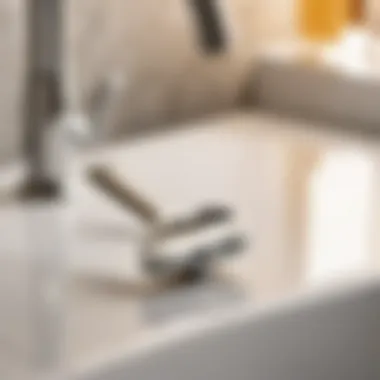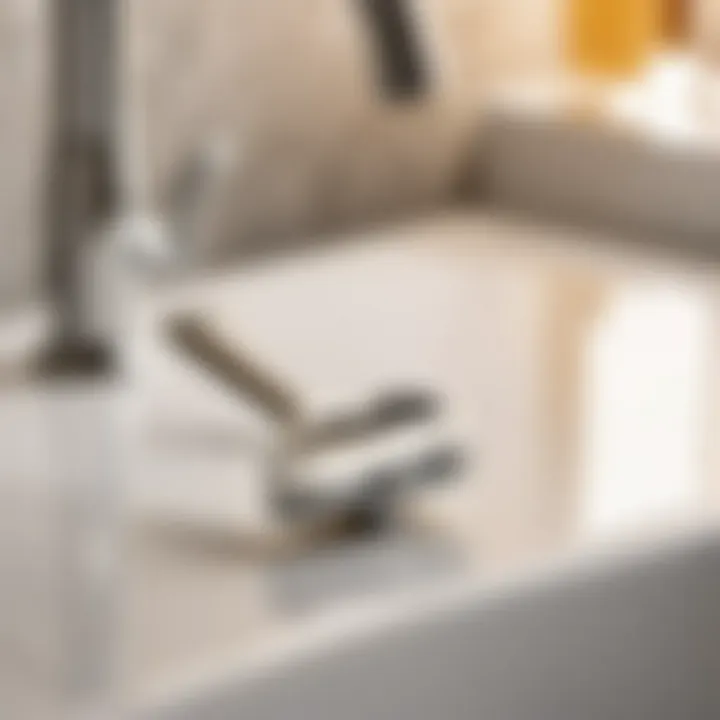Expert Tips for Bathroom Sink Washer Replacement Done Right


Materials:
- Replacement washer - 1 piece of size 1 inch
- Wrench - 1 with a jaw capacity of 6 inches
- Screwdriver - 1 Phillips head
- Plumber's tape - 1 roll of standard size
- Cleaning rag - 2 pieces
- Bucket - 1 for water collection
DIY Steps:
- Turn Off Water Supply: Locate the shut-off valve under the sink and turn it clockwise until the water flow stops completely.
- Empty the Sink: Remove any items from the sink and place them aside to create a clear working space.
- Access the Washer: Use the wrench to carefully loosen the connecting nuts on the water supply lines attached to the faucet.
- Remove Old Washer: Unscrew the old washer using the screwdriver, ensuring not to damage the surrounding mechanism.
- Replace with New Washer: Place the new washer in the same position and secure it tightly for a proper seal.
- Reassemble: Tighten back the connecting nuts and ensure all connections are secure.
- Turn On Water Supply: Open the shut-off valve slowly to restore water flow and check for any leaks.
Technical Aspects:
- Time Required: 30 minutes to 1 hour
- Tools: Adjustable wrench, screwdriver, plumber's tape
- Skills: Basic understanding of plumbing mechanisms and hand tool usage
DIY Project Process:
Starting from preparing the workspace to shutting off the water supply, each step is crucial for a successful washer replacement. Ensure precision in handling tools and components to prevent any damage. For troubleshooting, inspect connections for leaks and double-check the tightness of fittings. By following each step meticulously, you can accomplish the washer replacement task efficiently and effectively.
Introduction
In the realm of household maintenance, the often-overlooked yet critical aspect is the bathroom sink washer. This definitive guide delves deep into the art of replacing washers in bathroom sinks, unveiling the secrets to a smoothly functioning plumbing system. Understanding this essential component is pivotal for ensuring your sink's longevity and optimal performance. Neglecting the washer's upkeep can lead to a cascade of issues, ranging from irritating leaks to decreased water pressure. By mastering this replacement process, homeowners can sidestep potentially costly repairs and preserve the efficiency of their plumbing fixtures. This comprehensive guide not only illuminates the significance of washer replacement but also empowers you with the knowledge and skills needed to undertake this task confidently. With a keen eye for detail and dedication to maintenance, you can enhance the lifespan of your bathroom sink and enjoy seamless functionality for years to come.
Understanding the Importance of Washer Replacement
In the realm of maintaining a functional and efficient bathroom, the role of washers in sink fixtures often goes overlooked, yet its significance cannot be overstated. Understanding the importance of washer replacement is paramount in ensuring the longevity and performance of your bathroom sink. By delving into this crucial aspect, homeowners can prevent potential issues down the line, ultimately saving time and money that may arise from neglect.


Regular inspection of your bathroom sink's washer is essential to identify early signs of wear and tear. A faulty washer can manifest itself through various telltale signs, such as persistent dripping or leakage around the sink fixture. Addressing these indicators promptly can prevent more significant disruptions in the future, underscoring the importance of proactive maintenance.
Moreover, the impact of a defective washer on the overall sink performance cannot be underestimated. A compromised washer can lead to decreased water pressure, inefficient water flow, and even potential water damage to surrounding areas. By recognizing the critical role of washers in maintaining optimal sink functionality, homeowners can appreciate the direct correlation between regular inspection and the smooth operation of their bathroom fixtures.
In essence, grasping the importance of washer replacement serves as a proactive measure in safeguarding your bathroom sink's efficiency and durability. By incorporating this essential practice into your maintenance routine, you lay the foundation for a hassle-free and robust plumbing system within your household. Stay tuned as we delve deeper into the intricate details of identifying signs of a faulty washer and understanding its implications on sink performance in the subsequent sections of this ultimate guide.
Preparing for the Replacement Process
In the realm of bathroom maintenance, preparing for the replacement process of a sink washer is a crucial step that should not be overlooked. This section serves as the foundation for a successful washer replacement, setting the groundwork for a seamless transition from start to finish. By emphasizing the significance of meticulous preparation, individuals can ensure that the overall process will be conducted efficiently and effectively.
When delving into the realm of preparing for washer replacement, one of the key elements to consider is gathering the necessary tools and materials required for the task. Having a comprehensive set of tools at hand, such as an adjustable wrench, pliers, a bucket, and the replacement washer, is essential to facilitate a smooth and uninterrupted procedure. These tools are not only instrumental in removing the faucet handle and replacing the washer but also aid in reassembly, ensuring a secure and leak-free outcome.
Additionally, meticulous attention to safety precautions is paramount when embarking on the journey of replacing a washer in a bathroom sink. Prioritizing safety measures, such as wearing protective gear like gloves and safety goggles, can mitigate potential risks and safeguard against accidents. Moreover, it is imperative to turn off the water supply before commencing the replacement process to prevent any water-related mishaps or damages. By adhering to these safety guidelines, individuals can alleviate any concerns and approach the task with confidence and peace of mind.
Step-by-Step Guide to Replacing the Washer
In this section, we will delve into the crucial steps involved in replacing the washer in your bathroom sink. The washer plays a vital role in preventing leaks and ensuring the smooth functioning of your sink, making this guide essential for maintaining a functional and efficient bathroom setup.
Replacing the washer is a fundamental task that can save you from potential water damage and inconvenience. By following the steps outlined in this guide, you can proactively address any issues related to your sink's washer, ultimately enhancing the lifespan of your plumbing fixtures.
Shutting Off Water Supply
Before you begin the washer replacement process, it is imperative to shut off the water supply to your sink. This step is crucial for preventing any water leakage or accidents during the replacement procedure. Start by locating the shut-off valves under the sink and turn them clockwise to close off the water supply.


Ensuring that the water supply is securely turned off will provide you with a safe working environment and allow you to proceed with the washer replacement without any concerns about water flow.
Removing the Faucet Handle
Once the water supply is successfully turned off, the next step involves removing the faucet handle to access the washer. Different faucet models may have varying methods for handle removal, so refer to the manufacturer's instructions if needed. Typically, this process involves using a screwdriver or an Allen wrench to detach the handle from the faucet body.
Carefully disassemble the components of the handle, keeping track of the order in which you remove them. This will facilitate easy reassembly later on and ensure that the washer replacement is carried out smoothly.
Replacing the Washer
With the faucet handle removed, you can now access the faulty washer. Inspect the condition of the washer to determine if it is worn out or damaged. Select a suitable replacement washer of the same size and type to ensure a proper fit.
Carefully remove the old washer and replace it with the new one, making sure it is seated correctly within the assembly. This step is essential for restoring the seal and preventing leaks in your sink. Once the new washer is in place, proceed to reassemble the faucet components.
Reassembling the Faucet
After replacing the washer, carefully reassemble the faucet handle by following the reverse order of disassembly. Ensure that each component is snugly fitted and securely fastened to prevent any potential leaks.
Test the faucet by turning on the water supply and checking for any leaks or irregularities in the water flow. If everything appears to be in good working order, you have successfully completed the washer replacement process.
Testing and Troubleshooting
Testing and troubleshooting are integral parts of any maintenance task, and when it comes to replacing a washer in your bathroom sink, these steps are crucial to ensure everything is functioning optimally. By conducting thorough testing and troubleshooting, you can identify any potential issues early on, ultimately saving time and resources in the long run.


Properly testing the sink after washer replacement is essential to guarantee that there are no leaks or malfunctions. This step not only confirms the success of the washer replacement but also gives you peace of mind knowing that your sink is in top condition. By following the testing procedures outlined in this guide, you can rest assured that your efforts have been effective.
In addition to testing, troubleshooting plays a significant role in addressing any unforeseen challenges that may arise during the replacement process. Whether it's a minor leak or an unexpected issue with the faucet handle, troubleshooting allows you to pinpoint the issue and take appropriate measures to rectify it promptly.
Considering that water-related problems can lead to more significant issues if left unresolved, investing time in thorough testing and troubleshooting is a preventive measure that can save you from potential headaches down the line. By emphasizing these steps in your washer replacement routine, you not only ensure the immediate success of the task but also contribute to the long-term efficiency and durability of your bathroom sink.
Maintenance Tips for Prolonging Washer Lifespan
Proper maintenance is essential for ensuring the longevity and efficiency of your bathroom sink's washer. By following these maintenance tips, you can prevent costly repairs and keep your sink functioning optimally. Firstly, regular inspection and cleaning play a crucial role in prolonging the lifespan of the washer. Check for any signs of wear and tear, such as cracks or leaks, and promptly address them to avoid further damage. Cleaning the washer regularly with mild soap and water helps prevent buildup of debris and mineral deposits that can affect its performance. Additionally, lubricating the washer with silicone grease during inspections can help maintain its flexibility and prevent it from drying out, ensuring a tight seal and smooth operation. Remember to stay vigilant and proactive in your maintenance efforts to extend the lifespan of your washer and enjoy a trouble-free sink operation.
Regular Inspection and Cleaning
Regular inspection and cleaning of your bathroom sink's washer are vital for detecting potential problems early and preventing costly repairs. Begin by visually inspecting the washer for any visible signs of damage, such as cracks, discoloration, or distortion. Also, check for leaks or irregularities in water flow around the sink area. Cleaning the washer regularly with a mild detergent and warm water helps remove dirt, soap scum, and other residues that can compromise its sealing capabilities. Use a soft brush or cloth to gently scrub the washer and rinse it thoroughly to ensure all debris is removed. By maintaining a clean washer, you can prevent blockages, leaks, and other issues that may arise from neglect or lack of maintenance.
Avoiding Harsh Chemicals
When caring for your bathroom sink's washer, it's important to avoid using harsh chemicals that can cause damage or deterioration. Harsh cleaners containing bleach, ammonia, or acidic ingredients can degrade the washer material, leading to cracks, brittleness, or decreased flexibility. Instead, opt for gentle cleaning solutions like mild soap or vinegar to clean the washer effectively without causing harm. Avoid abrasive tools or scrubbers that can scratch the washer surface and compromise its sealing integrity. By steering clear of harsh chemicals and abrasive cleaning methods, you can preserve the quality and performance of your washer, ensuring smooth and leak-free operation for years to come.
Conclusion
In the realm of bathroom sink maintenance, the significance of understanding washer replacement cannot be overstated. As we conclude this detailed guide on the intricacies of bathroom sink washer replacement, it is imperative to reflect on the essential aspects covered.
Having delved into the importance of proactive maintenance and the step-by-step process of replacing a faulty washer, readers are now equipped with the knowledge and confidence to tackle this task efficiently. Acknowledging the signs of a faulty washer and comprehending its impact on sink performance are fundamental initial steps that can prevent potential larger issues down the line.
By meticulously following the preparation guidelines, including acquiring the necessary tools and materials, and embracing safety precautions, individuals can approach washer replacement with a sense of readiness and assurance. The subsequent step-by-step walkthrough, from shutting off the water supply to reassembling the faucet post-replacement, offers a comprehensive roadmap for a successful washer replacement process.
Moreover, the testing and troubleshooting phase aids in detecting leaks and addressing common issues that may arise during and after the replacement, ensuring a seamless transition. To prolong the lifespan of the washer and maintain optimal sink functionality, adhering to the maintenance tips provided, such as regular inspection and cleaning practices, is crucial.
In essence, this guide serves as a beacon of knowledge and empowerment for individuals looking to enhance their understanding of bathroom sink washer replacement. By implementing the insights shared throughout this article, readers can embark on their maintenance journey with confidence and achieve long-term efficiency in managing their bathroom sink's performance.







